warning light TOYOTA PRIUS C 2020 Owner's Guide
[x] Cancel search | Manufacturer: TOYOTA, Model Year: 2020, Model line: PRIUS C, Model: TOYOTA PRIUS C 2020Pages: 600, PDF Size: 12.02 MB
Page 190 of 600

1904-2. Driving procedures
PRIUS c_U■
If the hybrid system does not start (vehicles with immobilizer system)
The immobilizer system may not have been deactivated. ( P. 88)
Contact your Toyota dealer.
■ When the steering lock cannot be released
■ If the “READY” indicator does not come on
In the event that the “READY” indicator does not come on even a fter perform-
ing the proper procedures for starting the vehicle, contact you r Toyota dealer
immediately.
■ If the hybrid system is malfunctioning
P. 489
■ Key reminder function
A buzzer sounds if the driver’s door is opened while the power switch is in the
“LOCK” or “ACC” position to remind you to remove the key. When starting the hybrid system, the
power switch may seem stuck in the
“LOCK” position. To free it, turn the key
while turning the steering wheel slightly
left and right.
WARNING
■ When starting the hybrid system
Always start the hybrid system while sitting in the driver’s se at. Do not
depress the accelerator pedal while starting the hybrid system under any
circumstances.
Doing so may cause an accident resulting in death or serious in jury.
■ Caution when driving
Do not turn the power switch to the “LOCK” position while drivi ng. If, in an
emergency, you must turn the hybrid system off while the vehicle is moving,
turn the power switch only to the “ACC” position to stop the hy brid system.
An accident may result if the hybrid system is stopped while dr iving.
( P. 469)
Page 207 of 600

2074-2. Driving procedures
4
Driving
PRIUS c_U
To set the parking brake, fully
pull the parking brake lever
while depressing the brake
pedal.
To release the parking brake,
slightly raise the lever and
lower it completely while press-
ing the button.
■Parking the vehicle
P. 172
■ Parking brake engaged warning buzzer
A buzzer will sound if the vehicle is driven at a speed of appr oximately 3 mph
(5 km/h) or more with the parking brake engaged. ( P. 481, 492)
■ Usage in winter time
P. 274
Parking brake
Operating instructions
U.S.A. Canada
1
2
NOTICE
■Before driving
Fully release the parking brake.
Driving the vehicle with the parking brake set will lead to bra ke components
overheating, which may affect braking performance and increase brake
wear.
Page 216 of 600
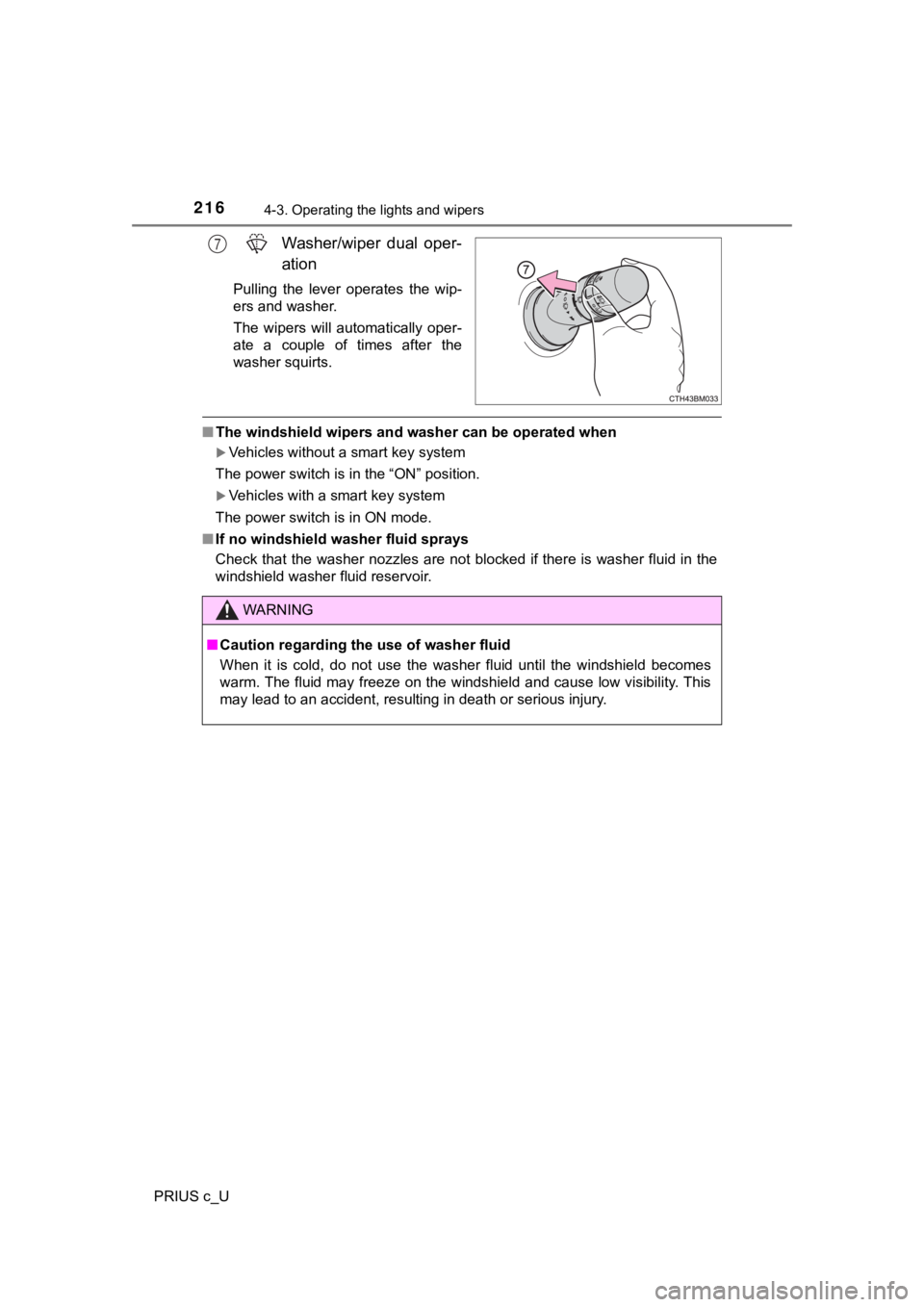
2164-3. Operating the lights and wipers
PRIUS c_U
Washer/wiper dual oper-
ation
Pulling the lever operates the wip-
ers and washer.
The wipers will automatically oper-
ate a couple of times after the
washer squirts.
■The windshield wipers and washer can be operated when
Vehicles without a smart key system
The power switch is in the “ON” position.
Vehicles with a smart key system
The power switch is in ON mode.
■ If no windshield washer fluid sprays
Check that the washer nozzles are not blocked if there is washe r fluid in the
windshield washer fluid reservoir.
7
WARNING
■ Caution regarding the use of washer fluid
When it is cold, do not use the washer fluid until the windshie ld becomes
warm. The fluid may freeze on the windshield and cause low visi bility. This
may lead to an accident, resulting in death or serious injury.
Page 228 of 600
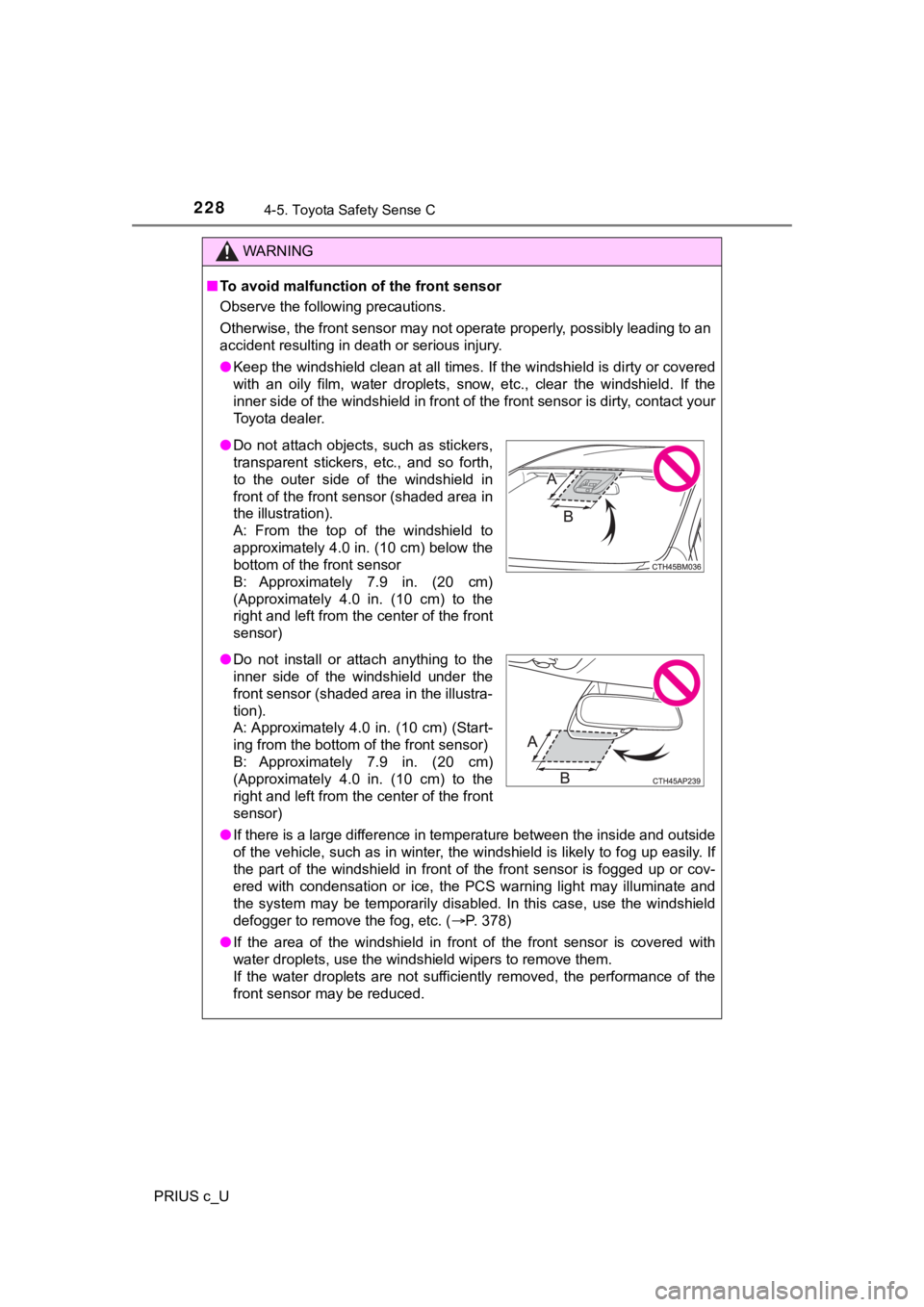
2284-5. Toyota Safety Sense C
PRIUS c_U
WARNING
■To avoid malfunction of the front sensor
Observe the following precautions.
Otherwise, the front sensor may not operate properly, possibly leading to an
accident resulting in death or serious injury.
● Keep the windshield clean at all times. If the windshield is di rty or covered
with an oily film, water droplets, snow, etc., clear the windshield. If the
inner side of the windshield in front of the front sensor is dirty, contact your
Toyota dealer.
● If there is a large difference in temperature between the inside and outside
of the vehicle, such as in winter, the windshield is likely to fog up easily. If
the part of the windshield in front of the front sensor is fogg ed up or cov-
ered with condensation or ice, the PCS warning light may illumi nate and
the system may be temporarily disabled. In this case, use the w indshield
defogger to remove the fog, etc. ( P. 378)
● If the area of the windshield in front of the front sensor is covered with
water droplets, use the windshield wipers to remove them.
If the water droplets are not sufficiently removed, the performance of the
front sensor may be reduced.
●Do not attach objects, such as stickers,
transparent stickers, etc., and so forth,
to the outer side of the windshield in
front of the front sensor (shaded area in
the illustration).
A: From the top of the windshield to
approximately 4.0 in. (10 cm) below the
bottom of the front sensor
B: Approximately 7.9 in. (20 cm)
(Approximately 4.0 in. (10 cm) to the
right and left from the center of the front
sensor)
● Do not install or attach anything to the
inner side of the windshield under the
front sensor (shaded area in the illustra-
tion).
A: Approximately 4.0 in. (10 cm) (Start-
ing from the bottom of the front sensor)
B: Approximately 7.9 in. (20 cm)
(Approximately 4.0 in. (10 cm) to the
right and left from the center of the front
sensor)
Page 229 of 600
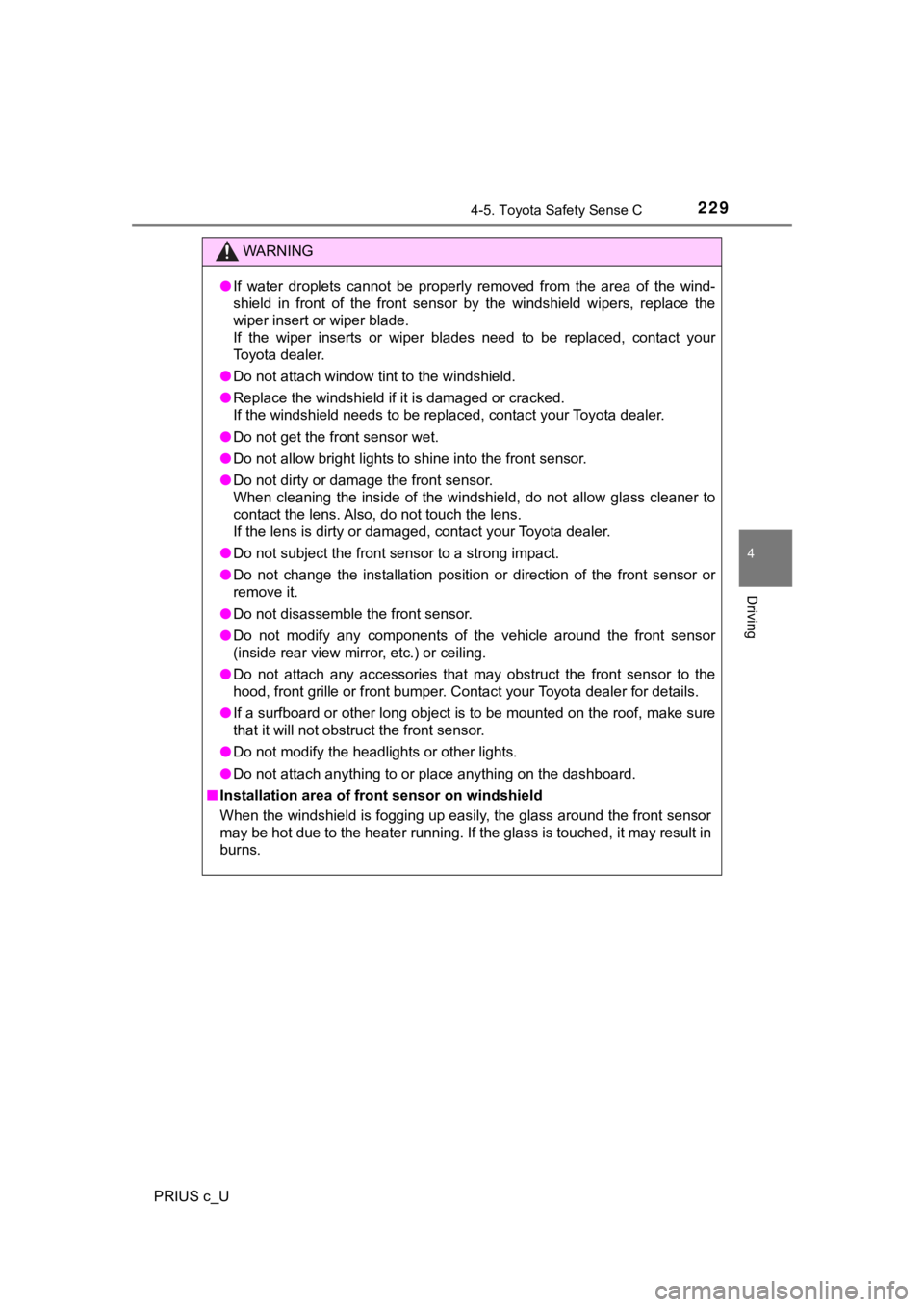
2294-5. Toyota Safety Sense C
4
Driving
PRIUS c_U
WARNING
●If water droplets cannot be properly removed from the area of t he wind-
shield in front of the front sensor by the windshield wipers, r eplace the
wiper insert or wiper blade.
If the wiper inserts or wiper blades need to be replaced, contact your
Toyota dealer.
● Do not attach window tint to the windshield.
● Replace the windshield if it is damaged or cracked.
If the windshield needs to be replaced, contact your Toyota dea ler.
● Do not get the front sensor wet.
● Do not allow bright lights to shine into the front sensor.
● Do not dirty or damage the front sensor.
When cleaning the inside of the windshield, do not allow glass cleaner to
contact the lens. Also, do not touch the lens.
If the lens is dirty or damaged, contact your Toyota dealer.
● Do not subject the front sensor to a strong impact.
● Do not change the installation position or direction of the fro nt sensor or
remove it.
● Do not disassemble the front sensor.
● Do not modify any components of the vehicle around the front sensor
(inside rear view mirror, etc.) or ceiling.
● Do not attach any accessories that may obstruct the front senso r to the
hood, front grille or front bumper. Contact your Toyota dealer for details.
● If a surfboard or other long object is to be mounted on the roo f, make sure
that it will not obstruct the front sensor.
● Do not modify the headlights or other lights.
● Do not attach anything to or place anything on the dashboard.
■ Installation area of front sensor on windshield
When the windshield is fogging up easily, the glass around the front sensor
may be hot due to the heater running. If the glass is touched, it may result in
burns.
Page 230 of 600
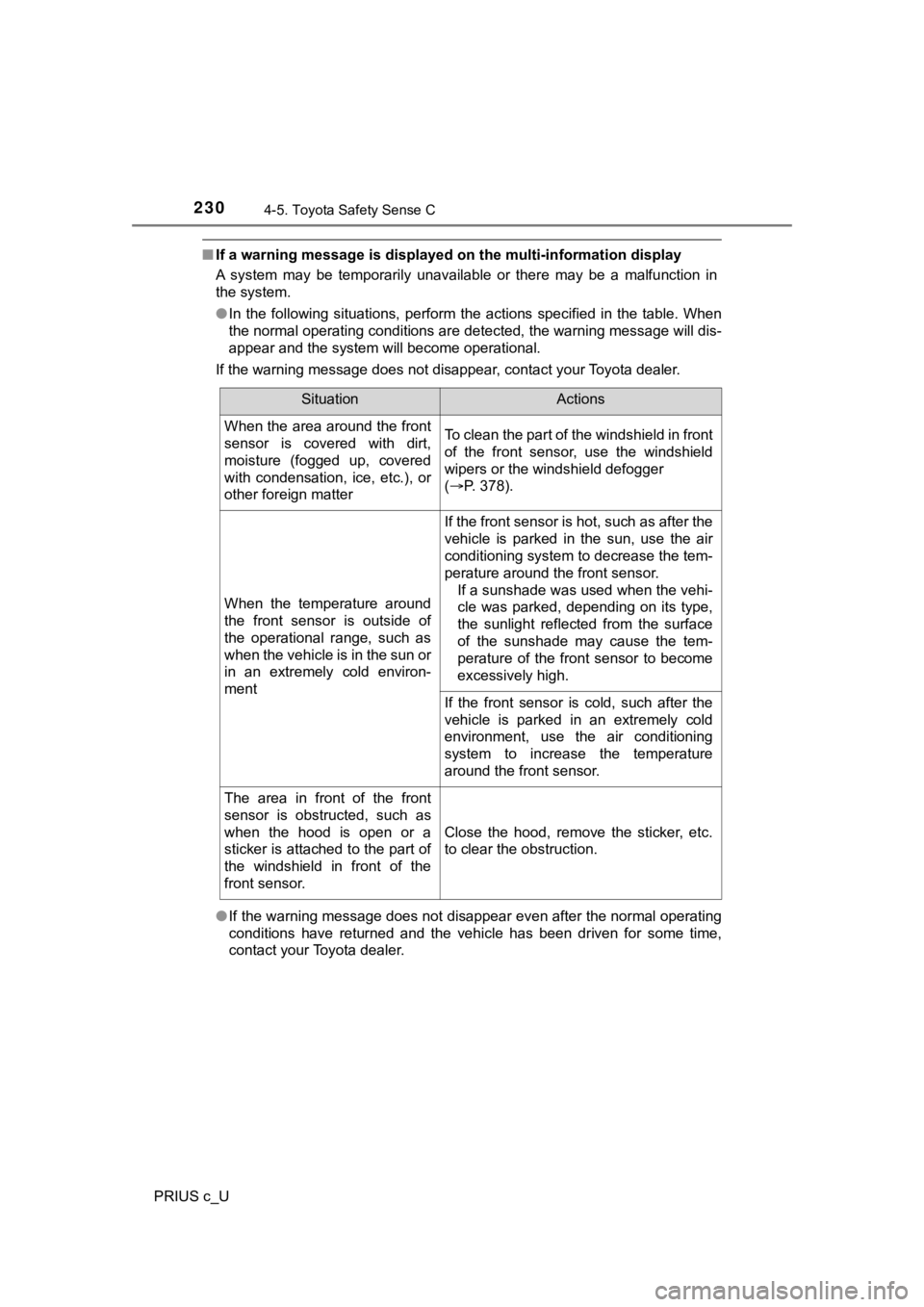
2304-5. Toyota Safety Sense C
PRIUS c_U
■If a warning message is displayed on the multi-information disp lay
A system may be temporarily unavailable or there may be a malfu nction in
the system.
● In the following situations, perform the actions specified in t he table. When
the normal operating conditions are detected, the warning messa ge will dis-
appear and the system will become operational.
If the warning message does not disappear, contact your Toyota dealer.
● If the warning message does not disappear even after the normal operating
conditions have returned and the vehicle has been driven for so me time,
contact your Toyota dealer.
SituationActions
When the area around the front
sensor is covered with dirt,
moisture (fogged up, covered
with condensation, ice, etc.), or
other foreign matterTo clean the part of the windshield in front
of the front sensor, use the windshield
wipers or the windshield defogger
( P. 378).
When the temperature around
the front sensor is outside of
the operational range, such as
when the vehicle is in the sun or
in an extremely cold environ-
ment
If the front sensor is hot, such as after the
vehicle is parked in the sun, use the air
conditioning system to decrease the tem-
perature around the front sensor.
If a sunshade was used when the vehi-
cle was parked, depending on its type,
the sunlight reflected from the surface
of the sunshade may cause the tem-
perature of the front sensor to become
excessively high.
If the front sensor is cold, such after the
vehicle is parked in an extremely cold
environment, use the air conditioning
system to increase the temperature
around the front sensor.
The area in front of the front
sensor is obstructed, such as
when the hood is open or a
sticker is attached to the part of
the windshield in front of the
front sensor.
Close the hood, remove the sticker, etc.
to clear the obstruction.
Page 234 of 600

2344-5. Toyota Safety Sense C
PRIUS c_U■
Disabling the pre-collision system
Press the PCS switch fo
r 3 seconds or more.
The PCS warning light will turn
on and a message will be dis-
played in the multi-information
display, when the system is
turned off.
To enable the system, press the
PCS switch again.
The system is enabled each
time the power switch is turned
to the “ON” position (vehicles
without a smart key system) or
the power switch is turned to ON
mode (vehicles with a smart key
system).
■
Changing the pre-colli sion warning timing
Press the PCS switch to display the current warning timing on the
multi-Information display. Each time the PCS switch is pressed
while the current warning timing is displayed, the timing for the
warning changes as follows:
The warning timing setting is retained when the power switch is turned
off. However, if the pre-collision system is disabled and re-en abled, the
operation timing will return to the default setting (middle).
Early
Middle
This is the default setting.
Late
Changing settings of the pre-collision system
1
2
3
Page 240 of 600
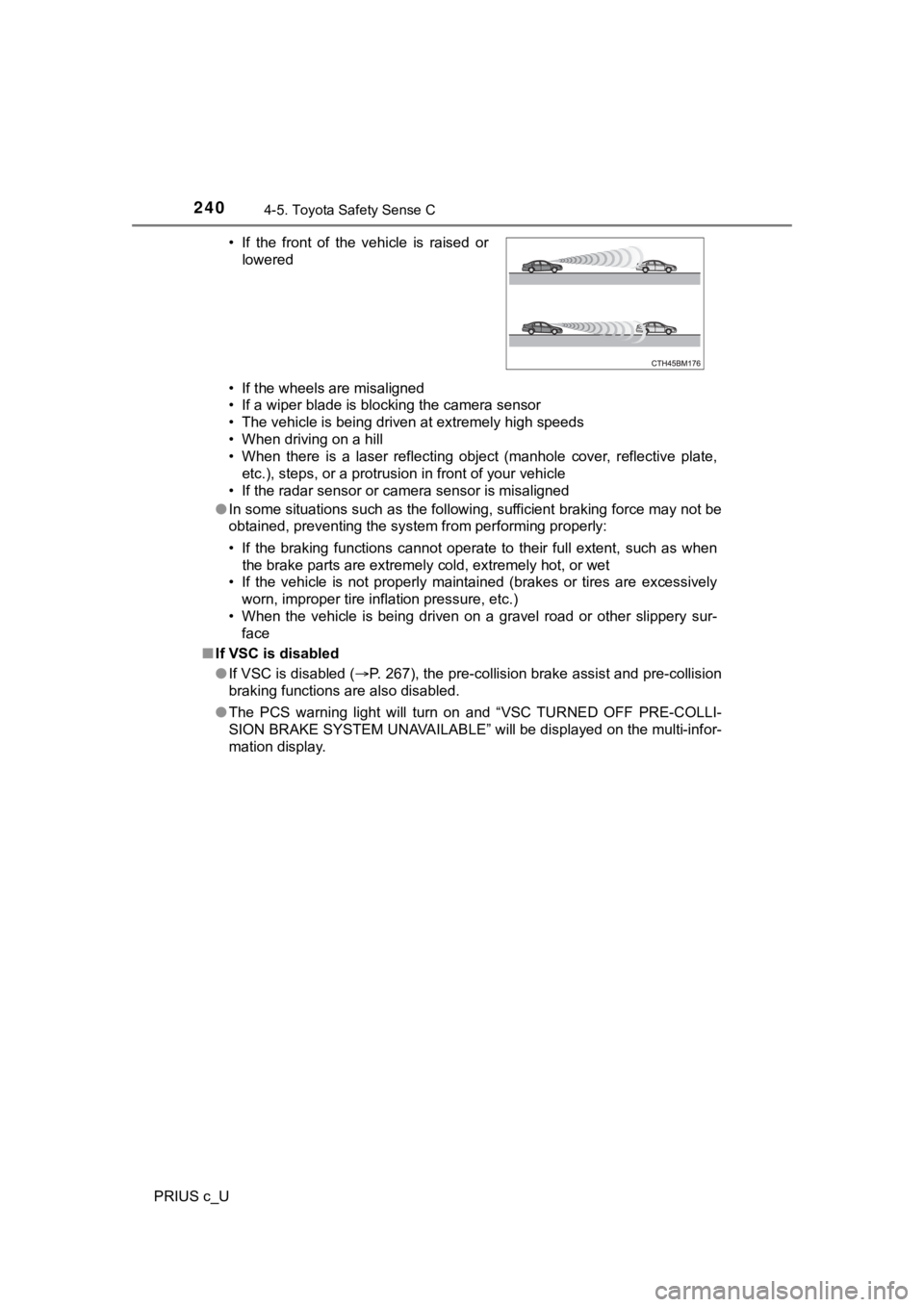
2404-5. Toyota Safety Sense C
PRIUS c_U• If the wheels are misaligned
• If a wiper blade is blocking the camera sensor
• The vehicle is being driven at extremely high speeds
• When driving on a hill
• When there is a laser reflecting object (manhole cover, reflec
tive plate,
etc.), steps, or a protrusion in front of your vehicle
• If the radar sensor or camera sensor is misaligned
● In some situations such as the following, sufficient braking fo rce may not be
obtained, preventing the system from performing properly:
• If the braking functions cannot operate to their full extent, such as when
the brake parts are extremely cold, extremely hot, or wet
• If the vehicle is not properly maintained (brakes or tires are excessively
worn, improper tire inflation pressure, etc.)
• When the vehicle is being driven on a gravel road or other sli ppery sur-
face
■ If VSC is disabled
●If VSC is disabled ( P. 267), the pre-collision brake assist and pre-collision
braking functions are also disabled.
● The PCS warning light will turn on and “VSC TURNED OFF PRE-COLL I-
SION BRAKE SYSTEM UNAVAILABLE” will be displayed on the multi-i nfor-
mation display. • If the front of the vehicle is raised or
lowered
Page 242 of 600
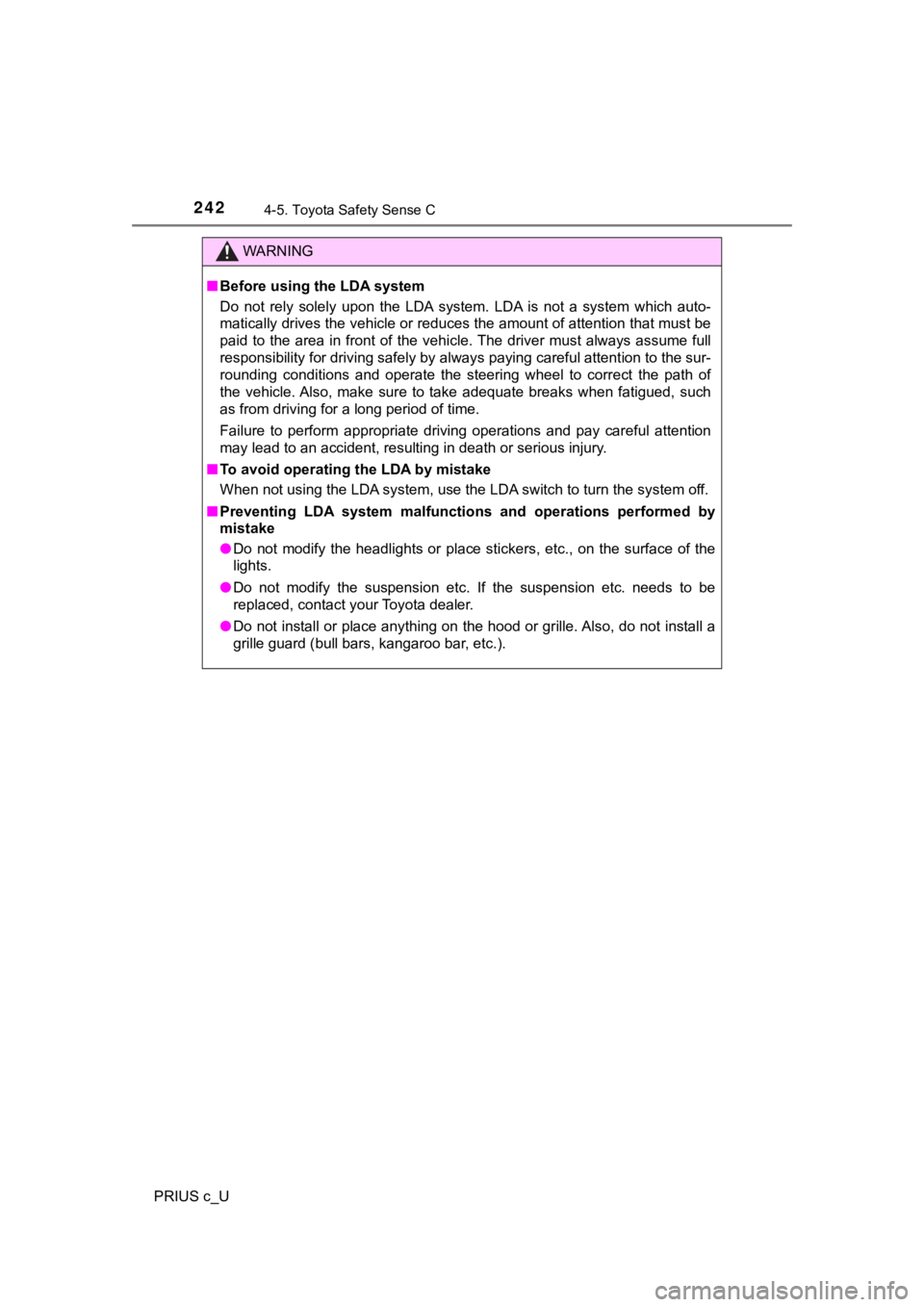
2424-5. Toyota Safety Sense C
PRIUS c_U
WARNING
■Before using the LDA system
Do not rely solely upon the LDA system. LDA is not a system which auto-
matically drives the vehicle or reduces the amount of attention that must be
paid to the area in front of the vehicle. The driver must alway s assume full
responsibility for driving safely by always paying careful atte ntion to the sur-
rounding conditions and operate the steering wheel to correct t he path of
the vehicle. Also, make sure to take adequate breaks when fatigued, such
as from driving for a long period of time.
Failure to perform appropriate driving operations and pay careful attention
may lead to an accident, resulting in death or serious injury.
■ To avoid operating the LDA by mistake
When not using the LDA system, use the LDA switch to turn the s ystem off.
■ Preventing LDA system malfunctio ns and operations performed by
mistake
● Do not modify the headlights or place stickers, etc., on the su rface of the
lights.
● Do not modify the suspension etc. If the suspension etc. needs to be
replaced, contact your Toyota dealer.
● Do not install or place anything on the hood or grille. Also, d o not install a
grille guard (bull bars, kangaroo bar, etc.).
Page 245 of 600
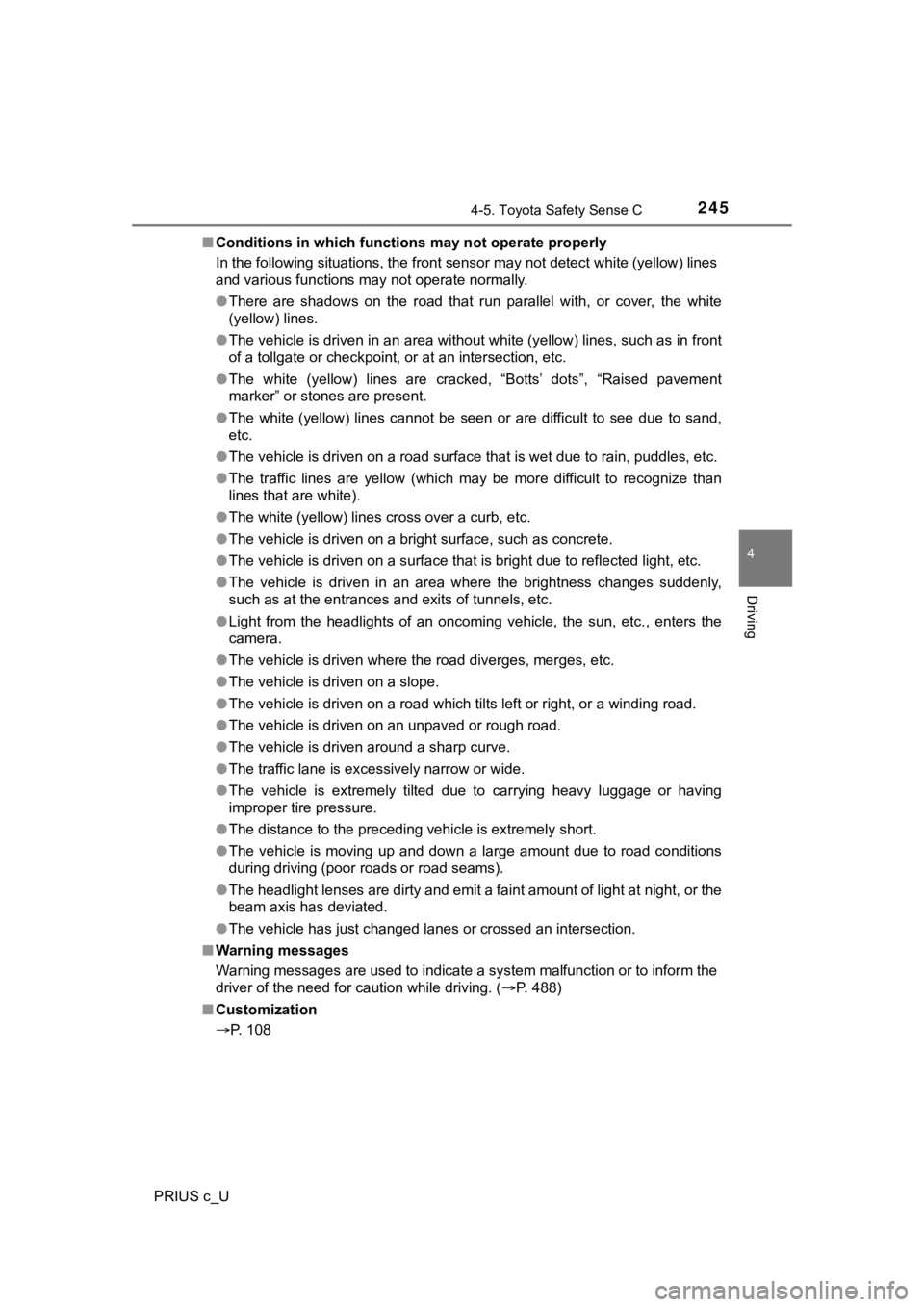
2454-5. Toyota Safety Sense C
4
Driving
PRIUS c_U■
Conditions in which functions may not operate properly
In the following situations, the front sensor may not detect wh ite (yellow) lines
and various functions may not operate normally.
● There are shadows on the road that run parallel with, or cover, the white
(yellow) lines.
● The vehicle is driven in an area without white (yellow) lines, such as in front
of a tollgate or checkpoint, or at an intersection, etc.
● The white (yellow) lines are cracked, “Botts’ dots”, “Raised pa vement
marker” or stones are present.
● The white (yellow) lines cannot be seen or are difficult to see due to sand,
etc.
● The vehicle is driven on a road surface that is wet due to rain , puddles, etc.
● The traffic lines are yellow (which may be more difficult to re cognize than
lines that are white).
● The white (yellow) lines cross over a curb, etc.
● The vehicle is driven on a bright surface, such as concrete.
● The vehicle is driven on a surface that is bright due to reflec ted light, etc.
● The vehicle is driven in an area where the brightness changes s uddenly,
such as at the entrances and exits of tunnels, etc.
● Light from the headlights of an oncoming vehicle, the sun, etc. , enters the
camera.
● The vehicle is driven where the road diverges, merges, etc.
● The vehicle is driven on a slope.
● The vehicle is driven on a road which tilts left or right, or a winding road.
● The vehicle is driven on an unpaved or rough road.
● The vehicle is driven around a sharp curve.
● The traffic lane is excessively narrow or wide.
● The vehicle is extremely tilted due to carrying heavy luggage or having
improper tire pressure.
● The distance to the preceding vehicle is extremely short.
● The vehicle is moving up and down a large amount due to road co nditions
during driving (poor roads or road seams).
● The headlight lenses are dirty and emit a faint amount of light at night, or the
beam axis has deviated.
● The vehicle has just changed lanes or crossed an intersection.
■ Warning messages
Warning messages are used to indicate a system malfunction or to inform the
driver of the need for caution while driving. ( P. 488)
■ Customization
P. 108